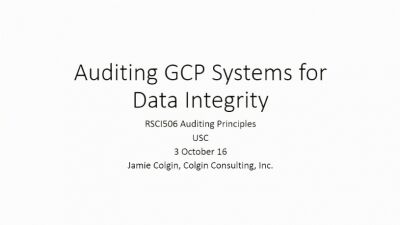- Data Integrity concepts
- ALCOA + CCEA
- Paper replaced with electronic files
- GMP inspections have revealed data integrity problems all over the world
- GCP systems
- EDC-Electronic Data Capture
- IWRS-Interactive Web Response
- Instrument Systems
- LIMS-Laboratory Information Management
- PIMS- Patient Information Management
- PV- Pharmacovigilance
- ECG reading systems
- Radiological image reading systems
- Programs to analyze and report subject data
- LMS-Learning Management
- EDMS- Electronic Document Management
- ETMF- Electronic Trial Master File
- CTMS- Clinical Trial Management
- Regulatory framework for enforcement
- Investigator, Sponsor and CRO are 3 responsible entities in a clinical trial
- Intended Recordkeeping ICH E-6: Investigators are responsible for all data in CRFs. Any discrepancies are the responsibility of the investigators.
- IVRS Provider, EDC Provider, ePRO Provider, CRO, Central Lab are all selected by the Sponsor. Sponsor delegates all the responsibilities.
- Investigator prepares case histories and sends data to the contractors/sponsors.
- Auditing for data integrity
- Quality Management System (QMS) auditing helps us verify that a provider has processes, procedures, equipment, facilities, supporting documentation and qualified personnel to provide high quality services.
- Data integrity audits show how a sponsor is preventing and detecting data integrity problems and risks.
- Preparing for a data integrity audit
- Review:
- Protocol
- Quality agreement
- Documented requirements
- Instructions provided and data transfer specifications
- Ask clinical team about problems they experienced
- Study manager
- Data manager
- Statistician
- Programmer
- Technical monitors
- Identify parameters that have a serious impact on subject safety:
- Exclusionary parameters
- Change in parameters
- Efficacy parameters
- Identify equipment used to create those parameters
- Research the equipment
- Draft a data flow diagram
- Review:
- Conducting a data integrity audit
- Don’ts:
- Read all QMS documents
- Focus only on computer system validation
- Review descriptions
- Read all disaster recovery plans
- Do’s:
- Work to develop high quality data
- Focus on implementation parameters
- Look at audit trails
- Pay careful attention to how flat files are managed
- Concentrate on QMS documents that support your work
- Don’ts:
Regulatory Science Symposium: Monitoring and Auditing Session 3: Auditing GCP Systems for Data Integrity (2016)
In this series, we will discuss data integrity, GCP systems, regulatory framework enforcement, and auditing for data integrity
Course Syllabus/Topics
Acknowledgement
Accompanying text created by Amelia Spinrad | Regulatory Knowledge Support Specialist | spinrad@usc.edu

